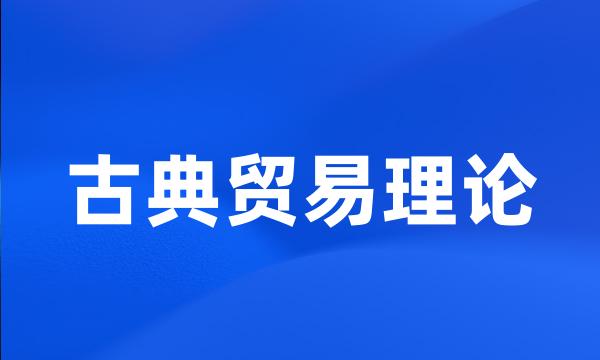古典贸易理论
- 网络classical trade theory;Classic Trade Theory;classical international trade theory
 古典贸易理论
古典贸易理论-
新兴古典贸易理论框架下的服务外包分析
An Analysis of Service Outsourcing in the Framework of New Classical Trade Theory
-
新兴古典贸易理论述评
A Review on New Classical Trade Theory
-
接下来,以传统国际分工为基础的古典贸易理论在重商主义的理论基石上应运而生。
Secondly , Classical international trade theory came out , and it based on the traditional international labor division .
-
而新兴古典贸易理论的发展,为解释国内贸易和国际贸易提供了一个统一的理论内核。
And the development of new classical trade theory provides a united theoretical core for explaining domestic and international trade .
-
古典贸易理论中,技术差异是比较成本差异的原因,比较成本差异导致国际贸易的发生;
The classical theories thought the difference in technology leading to difference in cost , which is the reason of the trade .
-
通过描述统计,本文得出古典贸易理论和规模经济均能较好地解释垂直专业化的结论。
Based on the description of statistics , this paper concluded that the classical trade theory and economies of scale all can better explain vertical specialization .
-
报酬递增和比较优势都是动态经济现象,但新贸易理论在分析时沿用的是新古典贸易理论中的静态分析方法。
Increasing return together with comparative advantage is a dynamic economic phenomenon , whereas the new trade theory applies to its analysis the static analytical method dominant in neoclassic trade theories .
-
对此,本文进行了严格的数学逻辑证明,并在此基础上构建了从古典贸易理论到新贸易理论的集成模型,证明了比较成本与机会成本的等价性。
The dissertation proves the viewpoint with mathematical logic method strictly , then constructs the integrated model from classical trade theory to the new trade theory , and proves the equivalence between comparative cost and opportunity cost .
-
分析了古典贸易理论的假设条件、资源基础、公共利益与可持续发展的不一致的问题,指出了现代贸易理论与可持续发展、尤其是与发展中国家的持续发展的矛盾。
The paper analyzes the issue that hypothetical conditions , resources foundation and public interest of the classical trade theory are inconsistent with sustainable development . It points out the contradiction between the modern trade theory and the sustainable development , especially , that in developing countries .
-
这一部分有三方面的内容:一是产业竞争力的理论渊源,主要介绍了古典贸易理论、克鲁格曼的新贸易理论和波特的竞争优势理论与产业竞争力的关系;
In this part there are three aspects : The first aspect involves the source of theory of the industrial competitiveness which mainly introduces the relation between the classical trade theory , Krugman 's new trade theory , Porter 's theory of competitive advantage and the industrial competitiveness .
-
本研究首先回顾了对外贸易发展观,其发展历程分成三个阶段,古典贸易理论,新古典贸易理论和新贸易理论,主要论述了绝对成本、生产要素禀赋和产品生命周期等理论。
This paper first takes a retrospect of foreign trade theory development . There are three stages in the history , classical trade theory , neoclassical trade theory and new trade theory , including such representative theories of absolute cost , product factor endowment and product life cycle .
-
比较优势理论包传统国际贸易理论、新国际贸易理论和新兴古典贸易理论;产业集群理论包括产业集群的形成条件、路径和作用;并分析两者之间的关系。
The comparative advantage theory includes the international trade theory , the new international trade theory and the new classical trade theory . The industrial cluster theory includes the condition , the path and the function of the industrial clusters . The relationship between the two theories is analyzed .
-
新兴古典国际贸易理论则以专业化分工来解释贸易。
New Classical theory explains the trade by specialization .
-
按历史发展的线索追溯国际直接投资的经济思想渊源&重商主义思想和古典国际贸易理论。
We trace the economic thought source of FDI theories according to the history clue .
-
由于古典的贸易理论模型不能解释这种现象,经济学家们便开始寻求新的解释。
As the classical trade theory could not explain this phenomenon , economists began to explore new explanations for IIT since that time .
-
古典国际贸易理论假定贸易主体内部均质且协整,在简化了分析的同时,与现实的差距越走越远。
Classic trade theory treats countries as homogeneous and integrative ones , which goes far away from the reality when it predigest the analyze process .
-
传统的新古典国际贸易理论否定国际直接投资的存在空间,但经济全球化的迅速发展现实则表明国际贸易和国际直接投资是相互促进发展的。
The traditional new classical international trade theory denies the existing space of international direct investment theory . The rapid development of transnational corporation indicates international trade and international direct investment expands together .
-
本章首先基于新古典国际贸易理论,分析了要素流动与人均收入水平收敛的内在机制,进而对要素市场扭曲与中国地区收入差距扩大的关系进行了阐述。
Based on the neo-classical trade theory , we analyze both the inner mechanism of the flow of factors and the convergences of income level . Furthermore , we discuss the connection between factors market distortion and the enlarging regional income disparity .
-
分析外贸竞争力相关概念内涵和相互关系,从古典国际贸易理论、新国际贸易理论、国际投资理论和竞争优势理论的视角分析外贸竞争力的理论来源,然后分析我国外贸竞争力的形成。
Relative concepts of foreign trade competitiveness and the correlation are analyzed . The theoretical origin of foreign trade competitiveness is discussed from the angle of the main points of traditional international trade theories , new international trade theories , international investment theories and national competitiveness advantage theory .
-
他统的基于新古典经济学的贸易理论认为自由贸易政策能够达到帕雷托最优,应当成为各国贸易政策的首选。
The traditional trade theory based on new classical economics adheres to the doctrine that government should prefer free trade policy in order to reach Pareto optimum .
-
在古典和新古典贸易理论中,一国的贸易模式取决于该国的比较优势。
Classical and neoclassical trade theory holds that a country 's trade pattern depends on its comparative advantages .
-
自由贸易理论的演变与发展大致可分为三个阶段,即古典学派的自由贸易理论、现代学派的自由贸易理论和二战以后的自由贸易理论。
The evolution and development of free trade theory can be divided into three phases : classical school , contemporary school and the World War Two .
-
无论产业间贸易理论(含古典、新古典贸易理论)、产业内贸易理论(新贸易理论)还是产品内贸易理论,都是比较成本优势理论在不同分工形态下的具体体现。
No matter whether the inter-industry trade theory ( including classical , neoclassical trade theory ), the intra-industry trade theory ( the new trade theory ), or the intra-product trade theory embodies specifically comparative cost advantage in different patterns of division .
-
古典、新古典国际贸易理论的贡献主要是揭示了贸易互利性的双赢理念,并解释了产业问贸易现象;
Both the classical and neo-classical theories reveal the truth that the division of labor in trade would be a win-win solution for both sides , and explain inter-industry trade .
-
国际(区际)贸易理论的发展大致经历了古典、新古典、新贸易理论以及新经济地理贸易理论等几个阶段。
The international and regional trade theory experienced stages as classical , neo-classical , New Trade and New Economic Geography trade theory .
-
国际贸易分工理论发展至今,已经有200多年的历史了,期间经过古典阶段、新古典阶段和新贸易理论阶段,反映了国际贸易发展不同阶段的特点。
With a history of more than 200 years , the division of labor theory in international trade has gone through three stages : the classical period , the neo - classical period and the new trade theory period , each having distinct features in the development of international trade .
